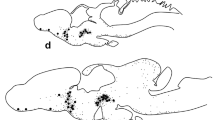Summary
Immunocytochemical studies were performed to describe the characteristics of cell types and their distribution in the pars distalis of Japanese long-fingered bat, Miniopterus schreibersii fuliginosus, collected at various stages of the reproductive cycle. Six distinct cell types have been identified in the pars distalis by the unlabeled immunoperoxidase technique and by the ABC method. Growth hormone (GH) and prolactin (PRL) cells were immunostained with antisera against chicken GH and ovine PRL. The GH-immunoreactive cells were round or oval orangeophilic cells distributed throughout the pars distalis with prominent aggregation in the posterolateral region. The PRL cells were pleomorphic carminophilic cells that occurred in small groups within the central and dorsocaudal regions of the pars distalis. They were sparsely distributed in the central region of the pars distalis in the hibernating bats, but increased significantly in the pregnant and lactating bats. The adrenocorticotropic (ACTH) cells were large round or polygonal amphophilic cells in the rostroventral and ventrolateral regions of the pars distalis. The thyrotropic (TSH) cells were small rounded or polygonal and distributed mainly in the ventrolateral region of the pars distalis. Luteinizing hormone (LH) and follicle-stimulating hormone (FSH) cells were identified immunocytochemically with antisera against the specific beta subunits of ovine LH and rat FSH. There were two populations of LH and FSH cells, one aggregated in the zona tuberalis and the other scattered singly throughout the rest of the pars distalis. The aggregated cells were immunoreactive with both antisera directed to LH and FSH, while scattered cells were reactive solely with antiserum to either LHβ or FSH and exhibited seasonal variations. In females, the proportional volume of the pars distalis occupied by LH cells was significantly reduced during pregnancy and lactation. No evidence of involution was observed in pars distalis cells except for PRL cells in males or females during hibernation.
Similar content being viewed by others
References
Anthony ELP, Gustafson AW (1984a) Seasonal variations in pituitary LH-gonadotropes of the hibernating bat Myotis lucifugus lucifugus; an immunohistochemical study. Am J Anat 170:101–115
Anthony ELP, Gustafson AW (1984b) A quantitative study of pituitary colloid in the bat Myotis lucifugus lucifugus in relation to age, sex, and season. Am J Anat 169:89–100
Anthony ELP, King JC, Stopa EG (1984c) Immunocytochemical localization of LHRH in the median eminence, infundibular stalk, and neurohypophysis. Evidence for multiple sites or releasing hormone secretion in humans and other mammals. Cell Tissue Res 236:5–14
Baker BL (1974) Functional cytology of the hypophysial pars distalis and pars intermedia. In: Handbook of Physiology; Section 7, Vol IV, RO Greep, EB Astwood (eds) Williams and Wilkins, Baltimore, pp 45–80
Dawson AB (1937) The relationships of the epithelial components of the pituitary gland of the rabbit and cat. Anat Rec 69:471–486
Goldberg RC, Chaikoff IL (1952) On the occurrence of six cell types in the dog anterior pituitary. Anat Rec 112:265–274
Green JD (1951) The comparative anatomy of the hypophysis, with special reference to its blood supply and innervation. Am J Anat 88:225–312
Hanström B (1952) The hypophysis in some South Africa insectivora, carnivora, hyzacoidea, proboscidea, artiodactyla, and primates. Ark Zool Ser 2, 4:187–294
Herlant M (1953) Étude comparative sur l'activité génitale des cheiroptéres. Soc Roy Zool Belg Ann 84:87–116
Herlant M (1956) Corrélation hypophyso-genitales chez la femelle de la chauve-souris Myotis myotis (Borkhausen). Arch Biol 67:89–180
Herlant M (1964) The cells of the adenohypophysis and their functional significance. Int Rev Cytol 17:299–382
King JC, Anthony ELP, Gustafson AW, Damassa DA (1984) Luteinizing hormone-releasing hormone (LH-RH) cells and their projections in the forebrain of the bat Myotis lucifugus lucifugus. Brain Res 298:289–301
Merchant FW (1974) Prolactin and luteinizing hormone cells of pregnant and lactating rats as studied by immunocytochemistry and radioimmunoassay. Am J Anat 139:245–268
Mikami S (1980) Comparative anatomy and evolution of the hypothalamo-hypophysial systems in higher vertebrates. In: Ishii S, Hirano T, Wada M (eds) Hormones, Adaptation and Evolution. Jpn Sci Soc Press, Tokyo; Springer, Berlin Heidelberg New York, pp 47–70
Patil DR (1974) Comparison of pituitary gland cytology in three species of leaf-nosed bats (Hipposideridae). J Anat 118:33–51
Purves HD (1966) Cytology of the adenohypophysis. In: Harris GW, Donovan BT (eds) The Pituitary Gland. London, Butterworths Vol 1, pp 147–232
Richardson BA (1979) The anterior pituitary and reproduction in bat. J Reprod Fertil 56:379–389
Richardson BA (1981a) Identification of prolactin and growth hormone cells in the pars distalis of the California leaf-nosed bat, Macrotus californicus. Am J Anat 161:427–440
Richardson BA (1981b) Localization of gonadotropic hormones in the pituitary gland of the California leaf-nosed bat (Macrotus californicus). Cell Tissue Res 220:115–123
Siegel JH (1955) Cytochemical and histophysiological observations on the basophils of the anterior pituitary gland of the bat, Myotis lucifugus lucifugus. J Morphol 96:223–264
Author information
Authors and Affiliations
Rights and permissions
About this article
Cite this article
Mikami, Si., Chiba, S., Hojo, H. et al. Immunocytochemical studies on the pituitary pars distalis of the Japanese long-fingered bat, Miniopterus schreibersii fuliginosus . Cell Tissue Res. 251, 291–299 (1988). https://doi.org/10.1007/BF00215836
Accepted:
Issue Date:
DOI: https://doi.org/10.1007/BF00215836




